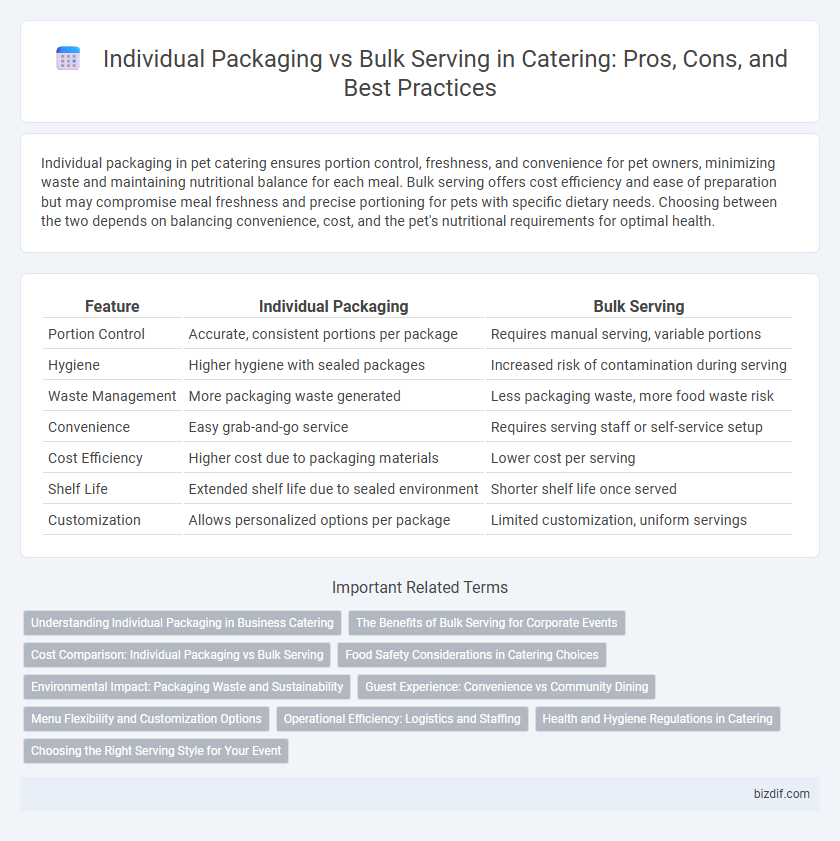Individual packaging in pet catering ensures portion control, freshness, and convenience for pet owners, minimizing waste and maintaining nutritional balance for each meal. Bulk serving offers cost efficiency and ease of preparation but may compromise meal freshness and precise portioning for pets with specific dietary needs. Choosing between the two depends on balancing convenience, cost, and the pet's nutritional requirements for optimal health.
Table of Comparison
| Feature | Individual Packaging | Bulk Serving |
|---|---|---|
| Portion Control | Accurate, consistent portions per package | Requires manual serving, variable portions |
| Hygiene | Higher hygiene with sealed packages | Increased risk of contamination during serving |
| Waste Management | More packaging waste generated | Less packaging waste, more food waste risk |
| Convenience | Easy grab-and-go service | Requires serving staff or self-service setup |
| Cost Efficiency | Higher cost due to packaging materials | Lower cost per serving |
| Shelf Life | Extended shelf life due to sealed environment | Shorter shelf life once served |
| Customization | Allows personalized options per package | Limited customization, uniform servings |
Understanding Individual Packaging in Business Catering
Individual packaging in business catering enhances hygiene and portion control, reducing food waste and ensuring consistent quality for each guest. It allows for easy distribution during events, supports dietary requirements, and minimizes cross-contamination risks. This packaging method is increasingly preferred in corporate settings seeking efficiency, safety, and personalized customer experiences.
The Benefits of Bulk Serving for Corporate Events
Bulk serving in corporate events enhances efficiency by allowing caterers to deliver meals quickly and reduce setup time, ensuring smooth service during tight schedules. It minimizes packaging waste, supporting sustainable event practices and lowering environmental footprint. Cost-effectiveness is another advantage, as bulk portions reduce expenses related to individual packaging and materials.
Cost Comparison: Individual Packaging vs Bulk Serving
Individual packaging increases per-unit costs due to higher material and labor expenses, while bulk serving reduces costs by minimizing packaging waste and streamlining portion control. Bulk serving typically lowers overhead by enabling larger-volume purchases and fewer distribution steps. Cost efficiency in catering often favors bulk serving unless customization and hygiene requirements justify the premium of individual packaging.
Food Safety Considerations in Catering Choices
Individual packaging reduces the risk of cross-contamination by limiting direct contact with food, ensuring higher hygiene standards in catering environments. Bulk serving may increase exposure to pathogens if proper temperature controls and handling protocols are not strictly followed. Safe catering practices prioritize temperature management, contamination prevention, and minimizing food handling to comply with food safety regulations.
Environmental Impact: Packaging Waste and Sustainability
Individual packaging in catering generates significantly more packaging waste compared to bulk serving, contributing to increased environmental pollution and landfill overflow. Bulk serving reduces single-use plastics and non-recyclable materials by minimizing packaging volume, supporting more sustainable practices. Catering businesses adopting bulk serving methods enhance resource efficiency and lower their carbon footprint while promoting eco-friendly catering solutions.
Guest Experience: Convenience vs Community Dining
Individual packaging in catering enhances guest convenience by ensuring personalized portions, reducing wait times, and minimizing contact for hygiene-conscious events. Bulk serving fosters a sense of community by encouraging shared dining experiences, promoting interaction and social bonding among guests. Balancing these approaches depends on event goals, with individual servings suited for efficiency and safety, while bulk options emphasize collaborative enjoyment.
Menu Flexibility and Customization Options
Individual packaging in catering enables precise menu customization, accommodating diverse dietary preferences and restrictions with tailored portions and ingredient choices. Bulk serving limits menu flexibility due to standardized portion sizes and combined dishes, reducing the ability to personalize meals for each guest. Customization options increase significantly with individual packaging, enhancing guest satisfaction through varied flavor profiles and presentation styles.
Operational Efficiency: Logistics and Staffing
Individual packaging streamlines logistics by simplifying transportation and reducing contamination risks, which minimizes the need for extensive handling and accelerates setup times. Bulk serving requires more staff for portioning and serving, increasing labor costs and complicating workflows. Efficient catering operations benefit from individual packaging by optimizing staffing levels and enhancing delivery precision.
Health and Hygiene Regulations in Catering
Individual packaging in catering ensures strict compliance with health and hygiene regulations by minimizing cross-contamination risks and enhancing food safety standards, particularly in high-risk environments. Bulk serving methods increase the likelihood of contamination through shared utensils and exposure, necessitating rigorous monitoring and frequent sanitization protocols. Regulatory bodies like the FDA and local health departments emphasize individual packaging as a preferred practice to maintain traceability and reduce the spread of foodborne illnesses.
Choosing the Right Serving Style for Your Event
Individual packaging offers enhanced hygiene and portion control, making it ideal for events prioritizing safety and convenience. Bulk serving promotes a communal atmosphere and reduces packaging waste, suitable for casual gatherings with environmentally conscious guests. Evaluating event size, guest preferences, and health protocols helps determine the most effective serving style for a seamless catering experience.
Individual packaging vs bulk serving Infographic

 bizdif.com
bizdif.com